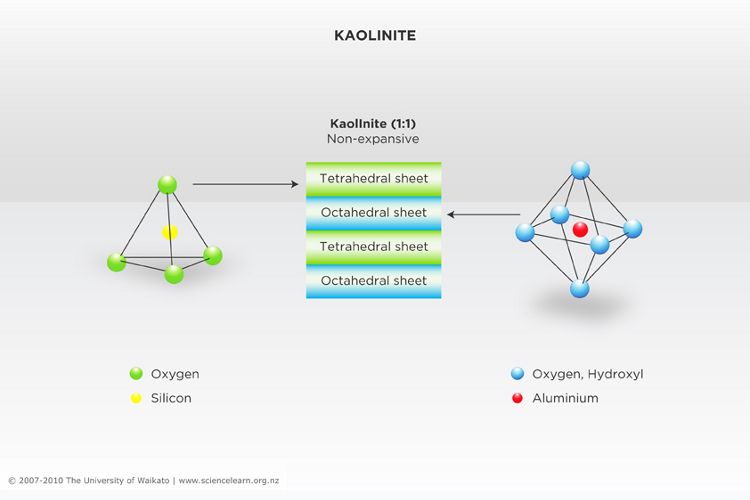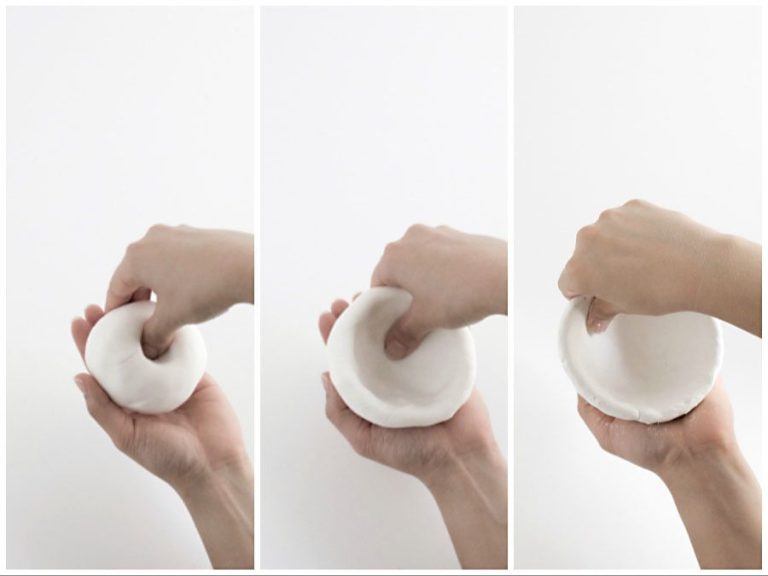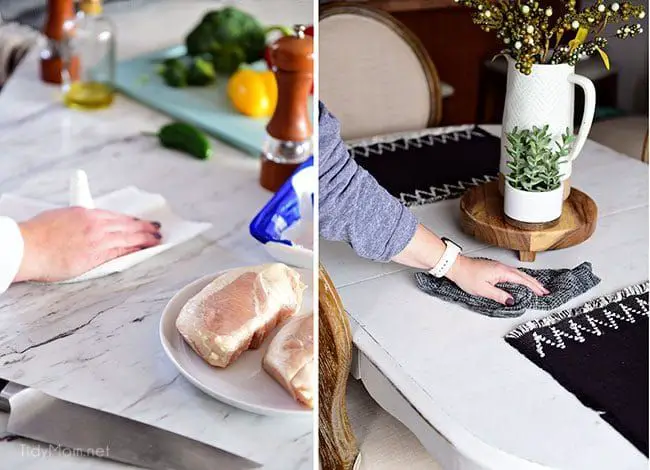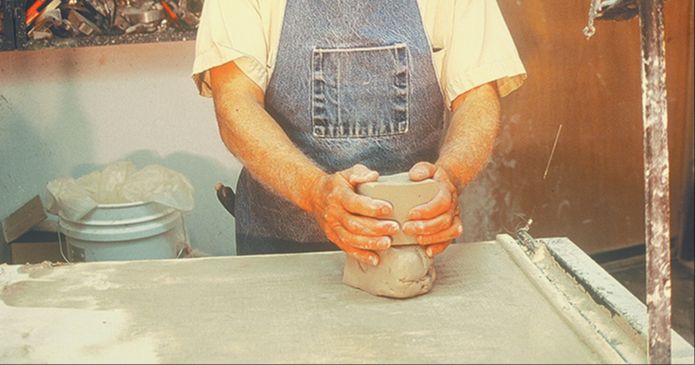What Is A Clay Simple Definition?
What is Clay?
Clay is a fine-grained naturally occurring earth material composed primarily of fine-grained minerals, which show plasticity through a variable range of water content, and which can be hardened when dried and/or fired. According to the Merriam-Webster dictionary, clay is “an earthy material that is plastic when moist but hard when fired, that is composed mainly of fine particles of hydrous aluminum silicates and other minerals, and that is used for brick, tile, and pottery”.
The key components that make up clay are the clay minerals. These are hydrous aluminum phyllosilicates, sometimes with variable amounts of iron, magnesium, alkali metals, alkaline earths, and other cations. Clays form flat hexagonal sheets similar to the micas. Clays differ from micas in that the sheets are held together by hydrogen and van der Waals bonds, which causes them to absorb water and swell, or shrink when dried.
The properties of clay that make it so useful include its plasticity, its ability to harden on firing or drying, its tendency to shrink or swell with changes in moisture content, its ability to adsorb other materials, and its general abundance. These properties allow clay to be molded into a variety of shapes and then harden into ceramic materials such as pottery, bricks, pipes, and tiles.
Some key properties of clay include:
- Plasticity – ability to be molded and retain shape
- Hardens when fired or dried
- Shrinks or swells with moisture changes
- Absorbent and adsorbent
- Abundant and widespread
Types of Clay
There are many different types of clay, but some of the most common include:
Kaolin clay, also known as China clay, is a very pure clay that is white or off-white in color. It is composed mainly of the mineral kaolinite and has many uses including ceramics, paint, cosmetics, medicine, and more. Source: https://en.wikipedia.org/wiki/Clay.
Bentonite clay forms from weathering volcanic ash and contains montmorillonite. It can absorb large amounts of water and has many uses including drilling fluids, cat litter, cosmetics, medicine, wine clarification, and more. Source: https://www.soulceramics.com/pages/types-of-clay.
Illite clay contains non-expanding clay minerals and forms from the weathering of micas. It is used for ceramics and construction materials. Source: https://en.wikipedia.org/wiki/Clay.
Fuller’s earth is a clay material composed mainly of palygorskite or bentonite. It has absorbent properties and is used for cat litter, industrial absorbents, and skin care products. Source: https://www.soulceramics.com/pages/types-of-clay.
Clay Formation
Clay is formed through the chemical weathering and decomposition of feldspar rocks. Feldspar is the most abundant group of rock-forming minerals and make up 60% of the Earth’s crust.
When feldspar comes into contact with water, it begins to break down in a process called hydrolysis. The feldspar reacts with water molecules and slowly dissolves. As it dissolves, the minerals that make up feldspar (aluminum, potassium, sodium, calcium, etc.) are released into a solution.
These dissolved minerals then combine with silica particles in the water to form clay minerals like kaolinite, montmorillonite, and illite. The specific clay mineral that forms depends on the composition of the original feldspar rock and the environmental conditions during weathering.
This chemical weathering process occurs over thousands or millions of years. It can happen on the Earth’s surface when rainwater permeates rock surfaces. Or underground water may penetrate cracks and slowly dissolve buried feldspar rock. The resulting clay minerals are carried away by water and deposited in lakes, rivers, soils, and sediments.
Over geological time, the continual chemical weathering of feldspar produces much of the clay present on Earth today. The decomposition of feldspar into clay minerals is one of the most important geological processes for supplying nutrients to soils and generating mineral resources.
Source: http://www.claygroundcollective.org/how-is-clay-formed-is-it-inorganic-or-organic/
Clay Composition
Clays are composed primarily of silica, alumina, and water, with small amounts of other elements. The chemical composition can vary based on the type of clay.
Silica (SiO2) is the most abundant component of clay minerals. It forms sheet-like tetrahedral structures with oxygen atoms. The percentage of silica in different clays ranges from 45-55% [1].
Alumina (Al2O3) is the second most prevalent component, making up 20-35% of clays. Alumina occurs in octahedral coordination, forming sheets that bind to the silica tetrahedral sheets. This layered structure gives clays their characteristic properties.

Water (H2O) is contained in interlayer spaces and as hydroxyl groups attached to the silica and alumina sheets. Water content can range from 5-10%, and affects the plasticity of clay.
Clay Properties
Some of the key properties of clay that make it so useful include:
Plasticity
Clay is highly plastic due to its chemical structure. This means it can be molded and shaped when wet, yet retains its shape when dried or fired. The plate-like structure of clay particles allows them to slide over one another when wet, but bond together when dry.[1]
Cohesiveness
The strong attractions between clay particles give clay high cohesion. This allows clay to be molded as a cohesive mass and retain its shape.[2] The cohesiveness depends on the type of clay minerals present.
Absorbency
Clay can readily absorb water and aqueous solutions into the spaces between its stacked particles. The absorption properties allow clay to be used for filtering and purifying applications.[1]
Uses of Clay
Clay has many diverse uses due to its unique properties and composition. Some of the most common uses of clay include:
Pottery
Clay is the primary ingredient in pottery and ceramics. Different types of clay have varying levels of plasticity, hardness when fired, color, etc which makes them suitable for creating pottery, tableware, sculptures, and other ceramic objects. Clay is shaped into the desired form and then fired in a high temperature kiln to permanently harden the clay. [1]
Construction
Clay is an important raw material used in construction. It is used to make bricks, cement, and can be added to plasters and mortars. Clay bricks are durable, fire resistant, and effective for insulation. Clay is also used to make roof tiles due to its waterproof nature. [2]
Paper
Clay is used as a filler and coating pigment in the production of paper. It is used to improve opacity, brightness, printing properties, and surface smoothness in paper products. Clay also improves the thickness and weight of paper. [3]
Clay in Agriculture
Clay has many important uses and benefits in agriculture. One of the main ways clay improves soil properties is through moisture retention. According to The Advantages and Right Kaolin Uses in Agriculture, clays like kaolin can absorb moisture and slowly release it to plant roots, preventing moisture stress in plants and reducing the need for frequent watering (https://www.yukami.co.id/use-of-kaolin-in-agriculture/). The absorptive properties of clay also allow it to retain dissolved nutrients, making them available to plants over a longer period of time.
In addition, clays can help improve the texture of soil. Adding clay to sandy soils helps them retain nutrients and water better. Incorporating clay into heavy compacted soils can loosen them and improve drainage. The binding characteristics of clays are also useful for controlling the release of fertilizers and other soil amendments (https://feeco.com/clay-a-staple-in-modern-agriculture-products/). Overall, clay’s moisture retention capabilities and ability to enhance soil texture make it an invaluable component of productive agricultural soils.
Clay Nutritional Benefits
Clay has been used for centuries as a natural remedy to promote health and aid the body’s detoxification process. Some of the nutritional benefits of clay include:
Detoxification: Certain types of clay are believed to help absorb toxins and impurities from the digestive system. The clay acts as a binding agent, adhering to heavy metals, chemicals, and other harmful substances and removing them from the body.
According to The Benefits of Clay as a Dietary Supplement, clay supplements can help remove waste and toxins, promote gut health, and support the body’s natural detoxification processes.
Skin Health: Applying clay masks or clay baths topically can help purify the skin. The minerals in clay help absorb excess oil and sebum while stimulating circulation. Clay’s absorbent nature helps draw out impurities from the skin, improving the appearance of acne, eczema, and skin irritation.
Clay facials can also exfoliate dead skin cells, reduce inflammation, and improve skin tone. As noted in Green Clay Bath is a Powerful Medicine, clay baths provide minerals that nourish the skin.
Clay Facials
Clay facials have become a popular skin care treatment due to the many benefits clay provides for the skin. Clays like bentonite and moroccan red clay are commonly used for facials. The clay is mixed with water or oils to create a paste that is applied to the face as a mask (https://www.themelanatedbar.com/collections/clay-facials/products/lavender-facial).
The clay facial process involves first cleansing the skin, then applying an even layer of the clay mask across the face while avoiding the eye area. The mask is left on for 10-15 minutes to dry before rinsing thoroughly with warm water. Exfoliation can follow to remove any remaining clay particles (https://www.herbneden.com/products/moroccan-red-clay).
Clay facials provide many benefits for the skin. The clay is able to bind to dirt and impurities, helping draw them out of the pores to deep cleanse the skin. Clays also absorb excess oils, making them great for oily and acne-prone skin. The minerals in the clay provide nutrients, while the pulling action stimulates blood circulation and promotes cell renewal. Common benefits reported after using clay facials include reduced acne, smaller pores, tighter skin, fading of scars/dark spots, and an overall healthy glow (https://www.themelanatedbar.com/collections/clay-facials).
Clay Crafts
Clay is a popular material for crafting due to its malleability and ability to be shaped, molded, and fired into permanent forms. Clay crafts encompass a wide range of creative techniques like pottery, sculpting, and jewelry making.
Pottery involves shaping clay into vessels like bowls, cups, plates, and vases. Items can be handbuilt by techniques like pinching, coiling, slab building, or thrown on a potter’s wheel. Once dried, pieces are fired in a kiln to harden them. Glazes can then be applied for decoration and to make the clay waterproof. Pottery allows immense creativity in shape, size, color, and function.
Clay sculpting involves molding figures, shapes, and reliefs from clay. The clay can be shaped by hand or using basic tools. Air drying sets the sculpture, or pieces can be fired for durability. Modeling clay stays malleable even when dry. Sculptures range from simple decorative objects to intricate artistic pieces.
Polymer clay is popular for jewelry making and small decorative items. The pliable clay can be shaped into beads, pendants, buttons, figurines, and more. After baking according to package directions, it hardens permanently. The cured clay can be sanded, drilled, and painted. Clay jewelry has an artisanal, handmade look and feel.
With myriad colors, textures, and finishes, clay offers limitless possibilities for imaginative crafts. It’s an accessible medium that stimulates creativity in both children and adults. From simple DIY projects to elaborate artistic works, clay crafts provide engaging hands-on fun.





